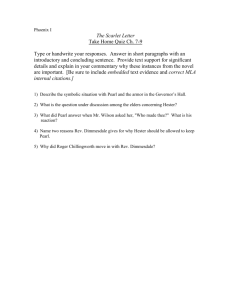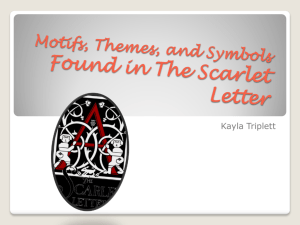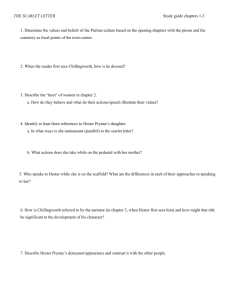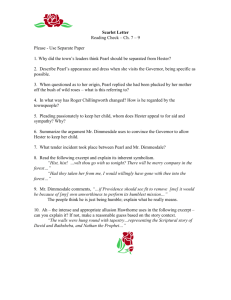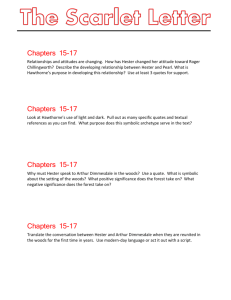The Scarlet Letter
advertisement
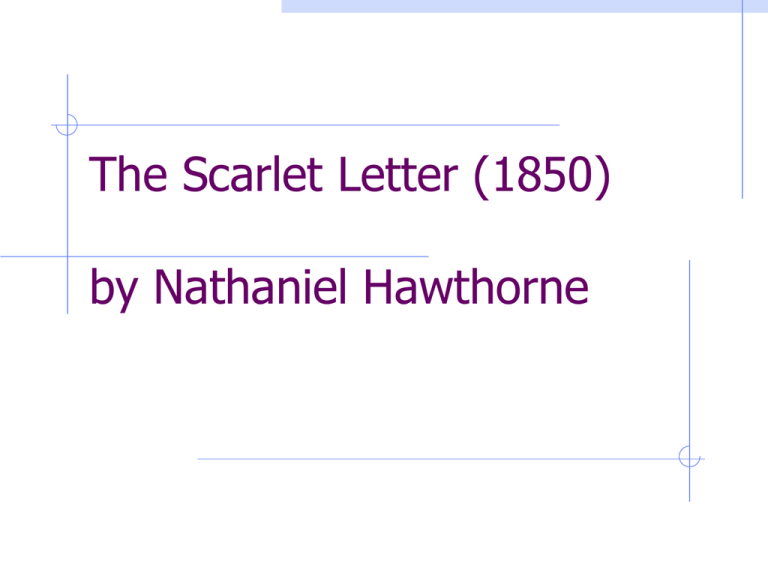
The Scarlet Letter (1850) by Nathaniel Hawthorne The Scarlet Letter The Scarlet Letter is peopled with characters who are meant to be the embodiments of moral traits, rather than realistic, living figures. It was initially supposed to be a short story, but Hawthorne was encouraged to lengthen it by his publisher The Scarlet Letter, in brief… It is often considered a difficult (boring?) text. Romantic diction- far away, distant, historical, elusive This story is not about action but about reflection. The most important action already happened before the novel begins. What do we make of that action? That one BIG mistake? SETTING Boston 1642-1649 (i.e., the 17th Century) Chapters 1-3 Market-Place. A June morning, 1642. Baby Pearl is about three-four months old Chapter 4 Prison. Afternoon of the same day. Chapters 7-8 Home of Governor Bellingham. Late summer, 1645. (Pearl is three years old) Chapter 12 Market-Place. Saturday night, early May, 1649 (Governor Winthrop’s death; Pearl is now seven years old) Chapters 14-15 Sea coast. Several days later. Chapters 16-19 Forest. Several days later. Chapters 21-23 Market-Place. Three days later. STRUCTURE Chapters 1-3: Hester’s ignominy is established Chapters 4-8: Hester and Pearl struggle in the community Chapters 9-11: Chillingworth and Dimmesdale Chapters 12-15: Hester’s evolution and her responsibility for the downfall of both men Chapters 16-20: The Forest-Talk and decision to be free! Chapters 21-23: Back to the marketplace; Dimmesdale’s victory over Chillingworth. Chapter 24: Conclusion What was Hawthorne’s point? There is beauty in darkness the rose-bush, Pearl, sunshine in the forest, etc. Nature can show pity and kindness regardless of human judgment Everyone could be wearing a letter of some sort; their hypocrisy hides their own sins Hester earns redemption through her good works- a Catholic philosophy that defies Puritan values of predestination There’s hope for humanity: “It’s the credit of human nature…it loves more readily than it hates.” (Ch. 13) Hawthorne’s ironic tone Chapter 1: A prison is one of the first things that was established in this “utopia”– the Puritan ideals were already prepared for failure! Chapter 2: The fat, ugly ladies gossip about Hester, but a pretty young mother defends her Gov. Bellingham says to Rev. Dimmesdale: “This woman’s soul lies with you.” Chapter 3: The baby cries at Dimmesdale’s voice… babydaddy recognition! Hawthorne’s ironic tone, cont. Chapter 5 Hester is the “Ralph Lauren” of Boston with her needlepoint; everyone wants her fashion– even Governor Bellingham (for his gloves). Only brides shun her. Chapter 6 “The truth was that the little Puritans, being of the most intolerant brood that ever lived…scorned them in their hearts, and not unfrequently reviled them with their tongues.” Does this sound Christian?! Chapter 10 Pearl dancing on important Puritan graves and flinging burrs at Hester and Dimmesdale Chapter 13 (four years later) “The whole system of society is to be torn down and built up anew.” – Hester is a STRONG woman; Hawthorne shows how it’s not nature’s intention for women to “keep women quiet.” Feminism? ‘A’ has become able. “The scarlet letter had not done its office.” Hester Prynne Openly acknowledges her sin of adultery Publicly accepts her punishment She wears the scarlet letter A which is elaborately embroidered by herself she humbly accepts all people’s derision and belittlement without feeling wronged; instead, she continues helping the poor and the diseased Effect of Hester Prynne’s Reaction Wins respect from the community and changing the meaning of the letter “A” on her bosom Becomes at peace with herself and with other people Grows stronger in mind Sees more clearly and thinks more critically about the people about her and the sins hidden in these people Things associated with Hester Prynne A blossoming wild rose-bush (could also be used to symbolize Pearl later in the novel) The sun and the shadows The scarlet letter “A” elaborately embroidered on the bosom of her gown Black hair and eyes Gray attire Seamstress Solitary sphere Arthur Dimmesdale He hides his sin of adultery Effects: - he suffers from increasing torment of conscience (his own hypocrisy); he’s often described as “tremulous” - he grows weaker both physically and psychologically (dims, fades away…) - he dies from the mental torture Things associated with Arthur Dimmesdale Eloquence & fervor / speech of an angel Nervous sensibility: tremulous mouth, melancholy brown eyes, apprehensive, startled and half-frightened look, emaciated form, gloom and terror, pain White: white brow, pale cheek The meteoric sign of the letter “A” Hand over his heart “Diminishing” overtime (hence his name) “Doctor” Roger Chillingworth His reaction to his wife’s adultery: - Revengeful - Hideously torments a human heart Effects: - changes into a cold-hearted (“chilled”) devillike man - loses humanity and motive to live after the object of his revenge (Dimmesdale) dies. Things associated with Roger Chillingworth Dim eyes Deformity: Misshapen shoulders Snake / horror / terror Blackness / darkness / dusk Somber, lonely, having a “chilling” effect Glare of red light / fire / flame Herbs, medicines Devil / Black Man in the forest Pearl Her reaction to her mom’s adultery: - Inquisitiveness/Precociousness - She’s the living embodiment of the scarlet letter Effects: - She is alienated from society, so she does not have friends with kids her age; she plays with fictitious enemies and animals in the forest - She is beautiful and grows up becoming a noblewoman who inherits Chillingworth’s riches. Things and people associated with Pearl “Elfish” Always adorned in bright colored clothing Beautiful: “brought forth in Eden” (ch. 6) Creative and precocious Affiliated with the sunshine Also symbolic of the rose-bush? Wild in nature, but a bright spot of beauty after a dark time Narrative method Telling vs. showing (Stephen King would cringe!) The main action of the novel happened before it even began! Narrative mode: omniscient narration with frequent author intrusions Romanticism rather than realism Unlikeliness of Pearl’s questions; later, she plays with a wolf in the forest?
